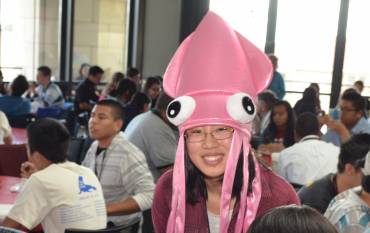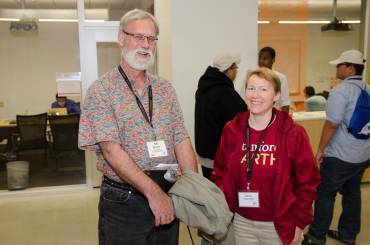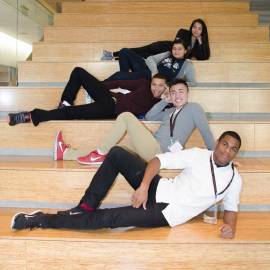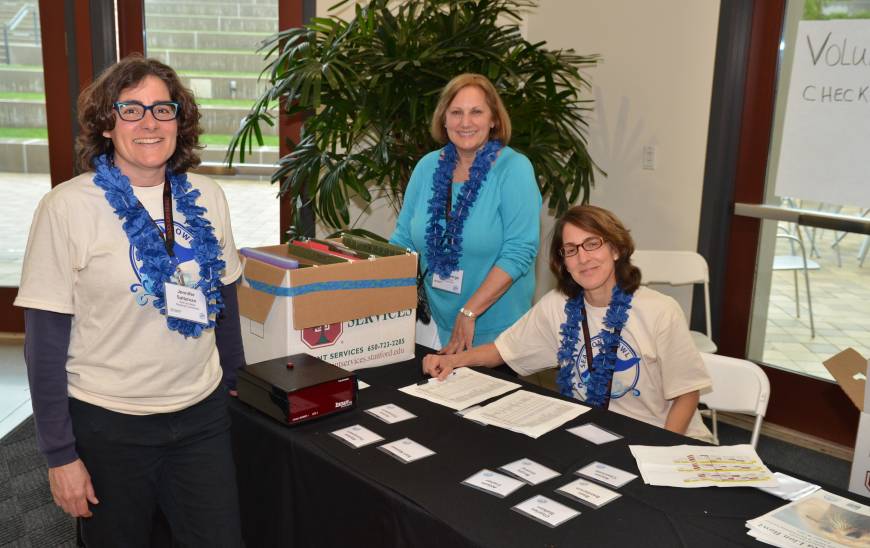The Stanford School of Earth, Energy & Environmental Sciences is now part of the Stanford Doerr School of Sustainability.
This page is currently being maintained for archival purposes only. For the latest information, please visit us here.
Oceans of questions, and answers
Stanford was swimming with high school students who competed in the Sea Lion Bowl, a challenging ocean sciences quiz event. The School of Earth, Energy & Environmental Sciences hosted the regional competition.
By
Mandy Erickson
Stanford School of Earth, Energy & Environmental Sciences
March 13, 2015

The ultimate varsity winners from Mission San Jose H.S. in Fremont, CA, work on a written quiz.
It was a win four years in the making. The high school seniors started as freshmen, filling their brains with information about the ocean — its currents, its creatures, its history and its geography.
Then they had one day to spill it all. During the Sea Lion Bowl at Stanford, the Mission San Jose High School varsity marine science team survived each round of the quiz show–style competition. And in the final square-off, the students from Fremont beat their opponents 85–45.
“I’m so excited,” said team captain Bethany Hung about going to the nationals in Mississippi in April. “All the work we’ve put into this competition over the past four years has paid off."
“This year, I knew we finally had a chance,” added Hung, who was carting a pink squid hat around Stanford’s Huang Engineering Center, where the competition took place Feb. 28. (She kept it on her lap while competing.) Hung and her teammates had decided to divide and conquer, with each member focusing on a specialty such as marine mammals or ocean geography. The strategy clearly paid off.

Team captain Bethany Hung of Mission San Jose
The Consortium for Ocean Leadership began sponsoring marine science bowls for high school students 18 years ago to fill an educational gap according to Kristen Yarincik, director of the National Ocean Sciences Bowl. “Fewer than half of high schools offer earth or environmental sciences classes. This is often the only way kids are exposed to oceanography,” Yarincik said.
In the past, San Francisco State hosted the Sea Lion Bowl, Northern California’s regional qualifying event, but budget constraints prevented the university from hosting last year. Students who wanted to compete headed to Oregon for the Salmon Bowl or Los Angeles for the Surf Bowl.
So, for the 2015 competition, Stanford stepped in. “We wanted to keep it going,” said Stanford professor Rob Dunbar, who was both the faculty sponsor for the event and a science judge during the competition. “It’s also spectacularly fun. It’s impressive when you see high school students perform at what is grad student level.” A leading oceanographer and climate scientist, Dunbar is the W.M. Keck Professor of Earth, Energy & Environmental Sciences at Stanford.

Prof. Rob Dunbar (left) was the faculty sponsor of the Sea Lion Bowl; Prof. Karen Casciotti, who studies marine chemistry, joined him to provide expert judging.
The Sea Lion Bowl attracted 82 students and 19 coaches who were supported by 78 volunteers in jobs such as judges, timers and scorekeepers. At the competition, which started at 8:15 a.m. and stretched until 6 p.m., two teams of four students each sat at long tables for each round. An official asked questions, and team members pressed buzzers when they had an answer. Each correct answer earned a team four points plus a chance at a six-point bonus question. The sessions included a written quiz, which the students completed together.
“I heard that the Sea Lion Bowl was competitive, and I’m the most competitive person I know, so I had to do it,” said Reginald Quartey, captain of the Oakland High junior varsity team. The sophomore joined the ocean bowl team because “it was a challenge to see how I could do.”
Quartey’s team came in fourth, which pleased Oakland High coach Jim Wallace, a counselor at the high school. The team began preparing only a few months before the competition, Wallace said, so, “given how late we started, they were great.”
Wallace added that the Sea Lion Bowl was a chance to show the students “something other than Oakland. It’s good for them to get out and see what the rest of the world has to offer. Plus, they learned that they can be competitive… they can be successful.”

Oakland junior varsity captain Reginald Quartey and his teammates can relax after earning a fourth place finish.
Coach Colleen Kelly, whose Mira Loma High School team traveled from Sacramento, has been coaching an ocean science team for several years. The biology and environmental science teacher likes to show her students the different directions a career in science can take them.
“Everyone wants to be a doctor,” she said, “but there are so many other things going on in science. Competitions like these open doors for some students.”
Besides receiving an all-expenses-paid trip to Ocean Springs, Miss., for the national competition, the winning team from Mission San Jose will receive a tour of the California Academy of Sciences in San Francisco.
The first-place junior varsity team and the second, third and fourth-place finishers at each level were awarded activities such as a whale-watching tour, a visit to Monterey Bay Aquarium and a sailing trip.

Dr. Jenny Saltzman (left) and her team organized the 2015 Sea Lion Bowl. Also shown are Celia Aufdemberge (center) and Genny Healy.
Stanford “most likely” will host the Sea Lion Bowl next year, said Jenny Saltzman, director of outreach education for Stanford’s School of Earth, Energy & Environmental Sciences and the event organizer. “It supports kids who want to learn about marine science in a way that is educational, engaging and enjoyable.”



